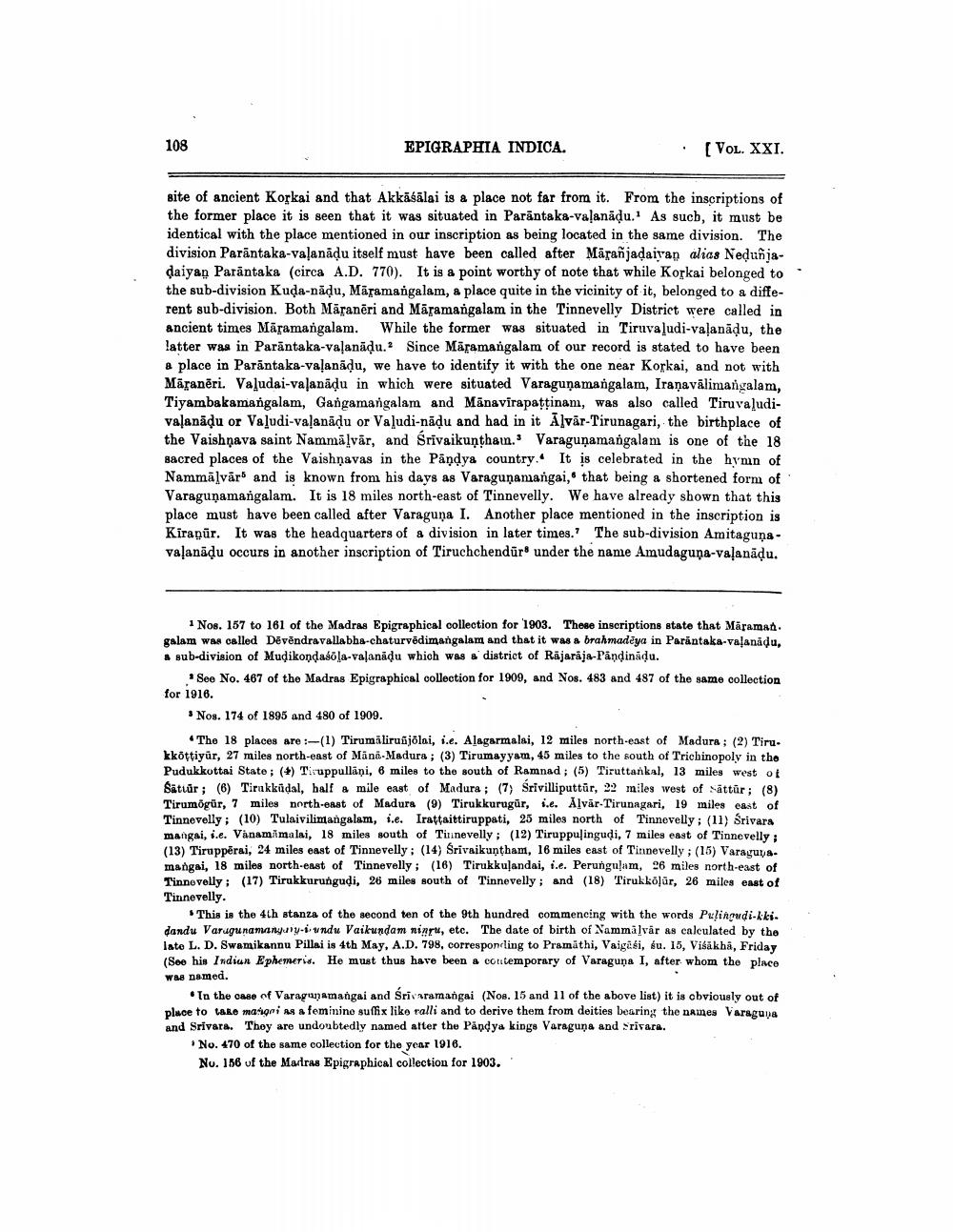________________
108
EPIGRAPHIA INDICA.
(VOL. XXI.
site of ancient Korkai and that Akkāśālai is a place not far from it. From the inscriptions of the former place it is seen that it was situated in Parāntaka-valanādu. As such, it must be identical with the place mentioned in our inscription as being located in the same division. The division Paräntaka-valanādu itself must have been called after Märañjadaiyan alias Nedunjadaiyan Parantaka (circa A.D. 770). It is a point worthy of note that while Korkai belonged to the sub-division Kuda-nadu, Māramangalam, a place quite in the vicinity of it, belonged to a different sub-division. Both Māranëri and Māramangalam in the Tinnevelly District were called in ancient times Māramangalam. While the former was situated in Tiruvaludi-valanādu, the latter was in Paräntaka-valanādu.2 Since Māramangalam of our record is stated to have been a place in Parāntaka-valanādu, we have to identify it with the one near Korkai, and not with Māranēri. Valudai-valanādu in which were situated Varaguņamangalam, Iranavälimangalam, Tiyambakamangalam, Gangamangalam and Manavirapattinam, was also called Tiruvaludivalanādu or Valudi-va!anādu or Valudi-nādu and had in it Āļvār-Tirunagari, the birthplace of the Vaishnava saint Nammālvār, and Srivaikunthain.Varaguņamangalam is one of the 18 sacred places of the Vaishnavas in the Pandya country. It is celebrated in the hymn of Nammālvārs and is known from his days as Varaguņamangai, that being a shortened form of Varagunamangalam. It is 18 miles north-east of Tinnevelly. We have already shown that this place must have been called after Varaguņa I. Another place mentioned in the inscription is Kiranür. It was the headquarters of a division in later times. The sub-division Amitagunavaļanādu occurs in another inscription of Tiruchchendūrs under the name Amudaguna-valanādu.
Nos. 157 to 161 of the Madras Epigraphical collection for 1903. These inscriptions state that Märaman. galam was called Dēvēndravallabha-chaturvēdimangalam and that it was a brahmadēya in Parantaka-valanādu, * sub-division of Mudikondasola-valanadu which was a district of Räjarija-Pändinädu.
See No. 467 of the Madras Epigraphical collection for 1909, and Nos. 483 and 487 of the same collection for 1916.
Nos. 174 of 1895 and 480 of 1909.
The 18 places are :-(1) Tirumaliruñjölai, i.e. Alagarmalai, 12 miles north-east of Madura : (2) Tiru. kkottiyur, 27 miles north-east of Mano Madura ; (3) Tirumayyam, 45 miles to the south of Trichinopoly in the Pudukkottai State ; (*) Tiruppullāņi, 6 miles to the south of Ramnad ; (5) Tiruttankal, 13 miles west of Sättúr; (6) Tirukküdal, half a mile east of Madura ; (7) Srivilliputtür, 22 miles west of Náttúr; (8) Tirumögür, 7 miles north-east of Madura (9) Tirukkurugūr, f.e. Alvár-Tirunagari, 19 miles east of Tinnevelly; (10) Tulaivilimangalam, i.e. Irattaittiruppati, 25 miles north of Tinnevelly: (11) Srivara mangai, i.e. Vinamimalai, 18 miles south of Tinnevelly : (12) Tiruppulingudi, 7 miles east of Tinnevelly; (13) Tiruppērai, 24 miles east of Tinnevelly : (14) Srivaikuntham, 16 miles east of Tinnevelly; (15) Varaguya. mangai, 18 miles north-east of Tinnevelly; (16) Tirukkuļandai, i.e. Perungulam, 26 miles north-east of Tinnevelly: (17) Tirukkurungudi, 26 miles south of Tinnevelly; and (18) Tirukkoļūr, 26 miles east of Tinnevelly.
This is the 4th stanza of the second ten of the 9th hundred commencing with the words Pulingudi-kki. dandu Varugunamanyury-bundu Vaikundam ninru, etc. The date of birth of Nammalvar as calculated by the late L. D. Swamikannu Pillai is 4th May, A.D. 798, corresponding to Pramathi, Vaigiéi, éu. 15, Visakha, Friday (See his Indian Ephemeris. He must thus have been a contemporary of Varaguņa I, after whom the place was named.
In the case of Varagunamangai and Srivaramangai (Nos. 15 and 11 of the above list) it is cbviously out of place to take mangni as a feminino suffix like ralli and to derive them from deities bearing the names Varaguna and Srivara. Thoy are undoubtedly named after the Pandya kinge Varaguna and Srivara.
• No. 470 of the same collection for the year 1916. No. 156 of the Marras Epigraphical collection for 1903.




